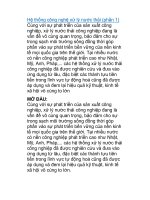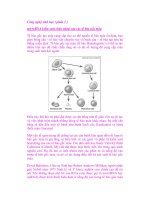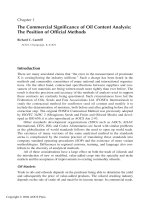Plant equipment design and layout White Paper phần 1 ppsx
Bạn đang xem bản rút gọn của tài liệu. Xem và tải ngay bản đầy đủ của tài liệu tại đây (333.04 KB, 8 trang )
Issued by: Siemens PLM Software. © 2011. Siemens Product Lifecycle Management Software Inc. All rights reserved.
Plant equipment design and
layout
Massive assemblies capability broadens footprint into plant
equipment design and layout.
W
hite Paper
White Paper | Plant equipment design and layout 2
Issued by: Siemens PLM Software. © 2011. Siemens Product Lifecycle Management Software Inc. All rights reserved.
Contents
Introduction 3
Plant equipment design and layout 4
Plant equipment industry overview 5
Design and engineering consulting companies 5
Machine design companies 5
Plant design companies 7
Plant equipment design and layout tools available in Solid Edge 9
Working with third-party data – translation 9
Large assembly layout capabilities 10
Display management capabilities 11
Efficient selection tools 11
Optimization capabilities 12
Large assembly drawing techniques 12
Digital analysis and engineering driven design tools 13
Revision management 14
Motion studies 15
Visualization 15
Managed design collaboration 16
Velocity Series 16
Conclusion 17
Additional reading 18
White papers 18
Case studies 18
3
White Paper | Plant equipment design and layout
Issued by: Siemens PLM Software. © 2011. Siemens Product Lifecycle Management Software Inc. All rights reserved.
For some time now, the advanced assembly design
capabilities of Solid Edge® software have been used
by many companies such as VAI, Anglo Platinum and
Krones to layout their factory floors and design
equipment for their plants. Solid Edge, a leader in
massive assembly design with many customers
creating assemblies of over 100,000 parts, now takes
the next step to making it even easier to lay out
factory floors with actual machine geometry, as well
as deal with other large assemblies in industries like
heavy industrial vehicles, large mechanical machinery
and process and power.
This white paper explores the plant equipment and
layout design market and identifies the most com-
mon challenges and design problems typically
associated with this industry.
Introduction
4
White Paper | Plant equipment design and layout
Issued by: Siemens PLM Software. © 2011. Siemens Product Lifecycle Management Software Inc. All rights reserved.
A plant or factory is a collection of machines that
work together to produce a finished product. A
complete plant not only contains production machin-
ery, but includes infrastructure such as power,
cooling, waste and ventilation systems. One example
of plant equipment design and layout is the layout
and development of equipment to transform raw
materials into a product through a series of punching,
bending, rolling and heating steps.
Below are some examples of plants that may or may
not produce a physical product. The most common
types are manufacturing operations, but a less
obvious example would be particle accelerators for
physics research.
Process
• Chemical processing
• Mining and quarry
• Particle accelerator
Utilities
• Power generation
• Water treatment
• Waste handling
Factories and manufacturing
• Production machines for consumer goods,
pharmaceuticals, white goods, electronics
• Packaging machines for consumer products,
food and beverages
• Raw materials production such as paper mill,
textiles and steel
This white paper will explore the main classifications
of these operations in terms of design requirements,
and identify typical problems these segments face
during the design process. A list of functionality
available from Solid Edge will be given and a brief
explanation of the problems are addressed. A more
detailed description of the specific capabilities found
in Solid Edge that address plant equipment design
and layout is provided at the end of this white paper.
Plant equipment design and la
y
out
5
White Paper | Plant equipment design and layout
Issued by: Siemens PLM Software. © 2011. Siemens Product Lifecycle Management Software Inc. All rights reserved.
The plant equipment design industry is made up of
three basic segments, each with their own challenges
and requirements. While some of the design process-
es and issues are common across the various
segments, this section points out some of the more
salient issues. It should be noted that while specific
capabilities in Solid Edge directly address the needs of
plant equipment design and layout, these tools easily
apply to any assembly design situation.
Design and engineering consulting
companies
Companies in this category include: contract archi-
tects, building contractors and machine design
companies, usually employed by a large manufactur-
ing company. Consultants identify the production
process and develop factory floor layouts for material
flow. Functional specifications are written for the
machines which are outsourced. In most cases,
factory designs only require material flows, space
envelopes and auxiliary systems. They are responsible
for coordinating equipment production and installa-
tion as well as overseeing the factory construction.
Consulting companies are generally smaller in terms
of people and are tasked with conceptual design as
well as obtaining project approval. Most likely initial
2D layout sketches are developed for equipment
position and location, but these need to migrate into
production designs. This is often a risky proposition
for consultants as proposals must be made before any
fit and position issues can be solved with 3D models.
Often, simple 3D models of the machines are used to
give a better sense of what the operation will look
like. High quality renderings of a “completed” factory
can enhance the overall presentation during the
design review phase. With some simplified 3D
models, fly-through animations are often used to
show how people will work and how vehicles can
move around the floor.
A large part of the design work for consulting
companies is in the development of a 2D plan-view
layout defining the entire operation. As there are
often common subsystems for material handling,
much data replication occurs but flexibility in copying
while moving or rotating is necessary. While many
companies work exclusively in 2D, the absence of 3D
makes solving fit and position problems difficult.
As these companies contract work to many different
vendors, several types of documentation are required
such as detailed written specifications for machine
vendors, 2D layouts for building fabricators and on
occasion 3D drawings for component manufactures in
cases where some design work is handled by the
consulting firm. A not so obvious requirement
resulting from this business model is hosting and
managing design reviews across vendors to ensure
machines are built to specification and schedules are
maintained.
While the design challenges extend into other areas,
the overview of this segment captures the major
problems consulting firms face. To address these
needs, Solid Edge includes a wide variety of function-
ality aimed at addressing: 2D factory layout design,
factory mockup with fly-through, and supply-chain
collaboration.
Machine design companies
Companies in this market space specialize in the
design and manufacture of production machinery.
Their work demands detailed machine requirements
and size restrictions supplied by either a consulting
company or a contractor. Since these companies
typically specialize in a particular type of machine
such as packaging, stamping or folding, existing
designs or technologies can often be leveraged into
new projects. As with any typical machine design
project, 2D data for the general material flow, size
Plant equipment industr
y
overview
6
White Paper | Plant equipment design and layout
Issued by: Siemens PLM Software. © 2011. Siemens Product Lifecycle Management Software Inc. All rights reserved.
and connection points are used to begin the design
process. Companies such as AMF, Angelus Sanitary
Can Machine Company, Changzhou Hengli Machinery
and Doucet Machineries Inc. are good examples of
machine manufacturers.
These types of companies generally have large design
teams that span multiple disciplines including
structural, motion, control systems and analysis.
However, there is usually a single lead engineer
assigned with managing the top level assembly and
ensuring all subassemblies and systems are integrat-
ed and fit together. It’s common practice that the lead
designer initiates the design of a machine by outlin-
ing the material or product flow with a 2D sketch
layout. Once created, individual subsystems are
identified and component engineers begin develop-
ing each section for a complete digital mockup before
manufacturing begins.
New projects often stem from an existing design and
with a goal to swap systems and components with
ones previously designed. This ala-carte approach
reduces costs and lead-times; however, it’s rare that
all parts and systems are available and simply need
assembling. During actual product development,
heavy usage of standard parts, such as fasteners and
bearings, are used.
The total number of parts in these types of machines
can range from the hundreds to tens of thousands.
The number of subassemblies can also vary depend-
ing on how the lead engineer organized the assembly
structure, but re-use of parts and assemblies is a
common practice. Designers strive to standardize
components in order to reduce overall costs and
machine lead time. Standardizing requires parts to be
created and
stored so that
they can be
“tweaked” on
the fly to
accommodate
future design
scenarios.
Machines are
typically high-
cost items and
custom devel-
oped for specific applications so they must be built to
last. Years of non-stop operation is a laudable goal
and to achieve this, components must be designed to
handle all operating conditions. While most compo-
nents are simply over-built, the effects of vibrations
are not easy to account for. Modal analysis can be
used to determine a part's natural frequency, and
knowing those values will help designers understand
where a component’s “shaking point” is. Motion
studies also help designers understand how moving
parts interact.
In terms of machines that make something, the
number of design reviews is proportional to
the number of parts and systems. Expect a significant
number of reviews when machines have several
operations and part counts exceed 1000. The most
common format for design reviews are 2D drawings.
Review costs can be reduced by using 3D models and
animations, simply because they are faster to create
and are easier to change.
Most companies in this segment do their own
manufacturing and assembly. While typical opera-
tions can include
machining,
welding,
bending, rolling
and other
common steps,
this subject is
out of the scope
of this white
paper. Consult
the Solid Edge
Structural
Frames and
Weldments
white paper for
more details.
7
White Paper | Plant equipment design and layout
Issued by: Siemens PLM Software. © 2011. Siemens Product Lifecycle Management Software Inc. All rights reserved.
Perhaps the most expensive aspect of engineering is
developing documentation. Most commonly it is in
the form of 2D drawings, complete with orthographic
drawing detail and auxiliary views – with full dimen-
sions and annotations. While it’s common to have one
drawing per part, in many cases, complex compo-
nents will require several drawing sheets. While these
drawings are automatically created from 3D models,
the process in pure 2D is laborious and lacks quick
change.
It may not be obvious at this point, but one machine
can have 10 subsystems, 100 subassemblies and
thousands of parts and thousands of drawings, so
managing this data is of prime concern. Finding,
revising, vaulting, printing, archiving are just some of
the needs here. This white paper will only outline
high-level issues; refer to Solid Edge Large Assemblies
for more details.
The design issues don’t end here, but the main
challenges such as data re-use, design with analysis
and drawing production have been identified. Solid
Edge is the leader in providing a complete solution for
machine design. Following this section is a complete
list of tools and workflows specifically designed for
this market.
Plant design companies
This final type of company is involved with all aspects
of plant design ranging from building size definition,
machine design, part production and machine
installation. As expected, these companies are global
in presence and have vast numbers of employees.
While they might outsource some of the work, their
main specialty is providing a turnkey solution for
companies requiring either mass produced products
or specialty processes. Some examples of these
companies are Siemens, Beumer and Krones.
These companies face many of the same challenges
as the previous operations, but host an additional
8
White Paper | Plant equipment design and layout
Issued by: Siemens PLM Software. © 2011. Siemens Product Lifecycle Management Software Inc. All rights reserved.
set of issues. While tasked with consulting, they must
also design and build the machines needed for the
process. This section will not list the issues previously
stated, but will only address new items.
Initial plant layouts are typically developed in 2D, but
as these companies typically develop machines using
3D tools, the need to integrate 2D layouts with 3D
models becomes obvious. Having this capability
would allow fast factory floor layouts, while realizing
the benefits of 3D such as visualization, solving fit
and position problems and facilitating part manufac-
turing. Having the best of both worlds – a mix of 2D
and 3D along with performance – is the ultimate
goal.
One of the biggest hurdles these companies face is
handling the amount of data associated with a plant.
Multiple machines containing thousands of parts and
the infrastructure, such as conveyors, electrical,
plumbing and even some of the building structure,
can easily grow a top-level assembly to 100,000
components. A complete 3D model will help validate
clearances, as well as enable animated shop floor
fly-throughs. Larger amounts of data require larger
computers, but a more subtle need is special tools
to make working with massive assemblies more
productive.
Assemblies of plants with this many parts require
huge design teams that generate massive amounts of
data. While product data management (PDM)
requirements are prevalent in all businesses, the need
here is more prevalent due to complicated workflows,
data being used by all parts of the organization and
the amount of users accessing, editing and reviewing
the data. This white paper will not attempt to explore
product data management issues as they are detailed
in a supplementary white paper on OEM Supply Chain
Collaboration.
Because these companies tend to handle all aspects
of design, analysis and manufacture, an integrated
solution is considered to offer the most productivity.
While most of the top systems have some level of
integration between applications, there always seems
to be issues with vendor support, licensing and
release synchronizations.
Because of the size and complexity of companies in
this segment, the issues and problems look endless.
The main challenges, however, are integrating 2D
layouts with 3D models, massive assembly support
and fusing software systems for multiple disciplines.
Solid Edge notably provides tools for a complete
solution for machine design including CAD, CAM, CAE
and PDM which is provided with Siemens’ Velocity
Series™ software portfolio.









